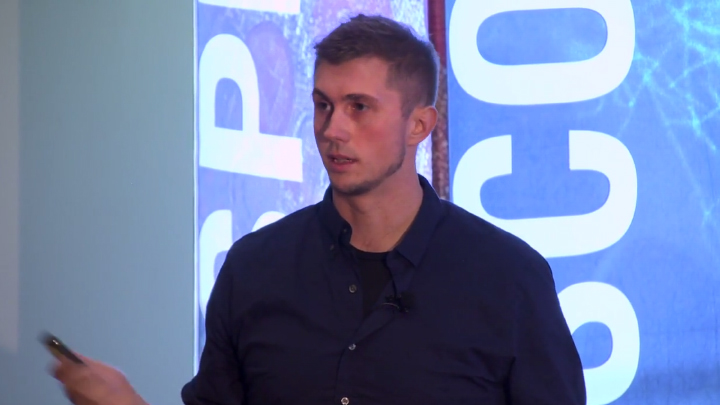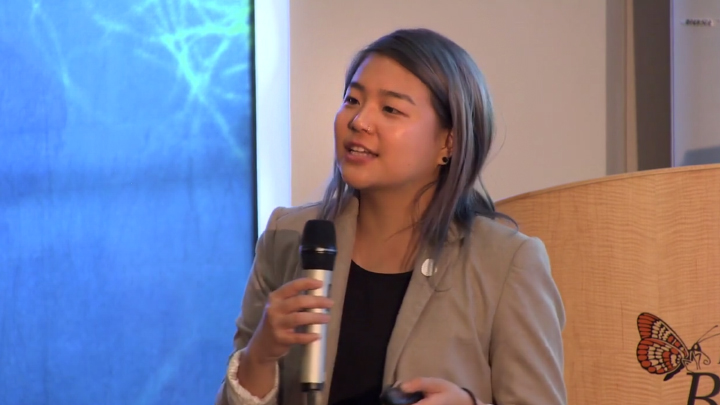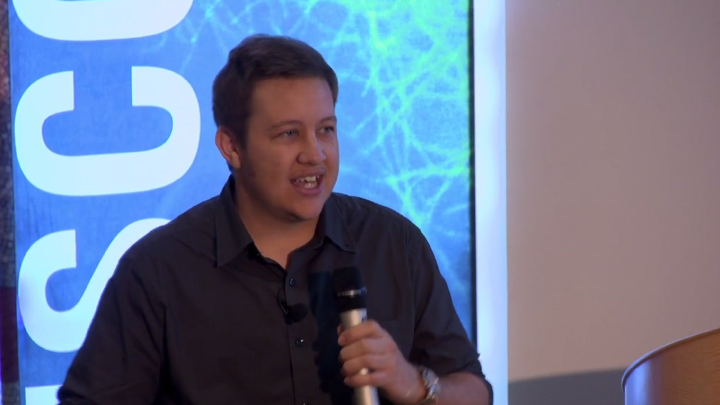Trees Inside Your Brain: Exploring the Purkinje Pattern
Script
Dana Simmons:
I am a grad student at the University of Chicago in their neurobiology program where I study autism and how it affects the cerebellum at the cellular level. What you're looking at here, this whole thing, is called a Purkinje cell. It's the principle type of neuron in the cerebellum. When I started doing experiments on these I was immediately struck by this very intricate branched pattern, and really the aesthetic quality that's present in these neurons. After looking at these under the microscope I thought hey, this is definitely art. And so, I make them into art by adding additional color filters, doing some background light manipulations, and seeing what the microscope can do beyond science.
To start out, here are some images of Purkinje cells that I've taken during my experiments in the lab. You can see these cells have a very stereotyped structure, so they start with the soma at the bottom. Then they have these primary dendrites, which are a little bit larger, and run up. And then they a very, very complex branch structure that subdivides many times. These are probably some of the most branched neurons in the nervous system. They come with a little bit of variation in shape, but they follow this Y shaped structure for the most part.
I have been, for the past year or two years, creating art out of these. Here are some examples of the images I've created. I brought a few with me today, if you want to see some of them. For my art I draw a lot of inspiration from Andy Warhol. I line my images up, so that you can see vertically these are the same neuron. These are the same neuron. I try to change the colors, change the filters, and see where it takes me. As you probably know, Andy Warhol was very famous for finding the beauty in everyday objects such as a Campbell's soup can. Now for me, and probably many of you, a brain slice and a neuron in a brain slice is an everyday object, so this is my art of everyday objects.
I'm really fascinated by the structure of these neurons. I try to create very striking images with a lot of color and a lot of contrast with the goal being that people will see them and say, what are those? What is a neuron? How do these work? Why are they important? It's really important to me to inspire curiosity, and questioning, and critical thinking. That's my goal with my art.
Now, I'm gonna tell you a little bit about how I create this art. I use a technique called patch clamp electrophysiology in combination with calcium imaging. What this means is that I take a brain slice, this whole thing here. I find a soma, meaning that there's a neuron there since we can't see the dendrites, and I patch the neuron, which basically just means attach a little micropipette to the soma, open the membrane, and basically use the pipette as a tube to flow fluorescent dyes into the neuron.
After about 30, or 40 minutes this is what results. It's really beautiful. I'm struck every single time when I see these under the microscope. The dye just diffuses through all the dendrites, the big ones, the small ones, and even the little dendrite spines, which are sticking off of the small branches.
Now for my experiments, I zoom in on one very small dendrite. I find a little spine, which is circled in red. I use calcium imaging to get a visual confirmation of how the calcium currents are flowing through these spines to learn about things like synaptic transmission, and synaptic plasticity in the autistic cerebellum compared with the wild type cerebellum. After the experiment is done though is when the art begins.
At the end of each experiment I take a picture of each neuron, not just for the art even though that's awesome, but because we have to be able to go back and say this is the exact dendrite and the exact spine that we measured. Here is how this neuron turned out. This is one of my favorites. The color here is obtained with extra background light from the microscope. It shows some of the texture in the brain slice, so they're never perfectly flat. Although, that might be easier for experiments, but not as good for the art. The colors here in the branches indicate how much dye is present in the dendrite, so the thicker branches have more dye in them.
One of the things that really fascinates me about these neurons, again, is their tree like structure. I call it the Purkinje Pattern. I think it's really fascinating that these patterns are present all throughout both microscopic and macroscopic nature. So here, this neuron from top to bottom is probably about 100 microns. This similarly shaped tree could be 50 feet tall. The tree that we heard about earlier has a similar shape. It has all these subdividing branches. We can see this shape in other parts of nature as well, in lightning, in coral, even in antlers, in capillary networks, veins on a leaf, even in social media diagrams, and connections with nodes, and even in the way we make our everyday decisions.
Now speaking of decisions, one thing that I think about a lot when I work with my art is that I've notice around the country, and perhaps other places there's a lot of resistance to science these days, and that troubles me a lot. I have a feeling it probably troubles a lot of people in this room as well. And so, my goal with my art, again, is to ask people to ask questions and inspire curiosity, but also to bridge science with art. I want to inspire creative people to look at scientific analytical things, and I want analytical people to branch out and say hey, I'm gonna try a creative thing today. I'm gonna do something a little bit different.
With that in mind, I applied for the Bridge Residency at the SciArt Center of New York where I was placed in a partnership with Richelle Gribble. She is a California based artist who does art based on interconnectivity and networks, so we were really a great match. Together we created a book, which I brought with me today. It's over there. This book addresses topics such as, What is a neuron? Why do scientists use mice to study diseases? We even do a little bit of neuro myth busting like, is it true that we only use 10% of our brain? Which we now know is not true.
And so, I wrote the text. It's real science of real people. The goal is to be accessible. Richelle created accompanying illustrations, which always impress me when I look at her work. They're based on images from the lab as well as images she found online. And if you're interested you can purchase this book through the SciArt Center's website. But it's been a fabulous experience working with her, and it's really enhanced my lab work.
So, with that I'd like to say thank you once again for having me here today. I'm extremely honored and thrilled to be here. I also want to thank the lab that I'm in for supporting me through this, the SciArt Center, and The Chicago Fine Arts Fund for funding some of my art. Here's my contact information. Thank you.
Related Videos
-

Microbes are Beautiful -

Communicating Science with Zines -

The Animated Foundations of Ecology

